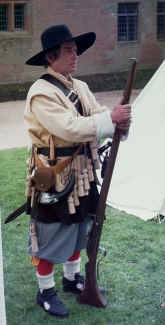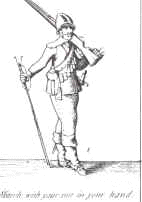
Musket Drill
The Musketeer, as the name implies, is a soldier who fights primarily
with a musket. A musket is a muzzle-loading gun, which means the ammunition
is fed into the muzzle, the opening at the end of the barrel. There
is a picture of a musket on the 'weapons' page.
Equipment
The musketeer has to carry a large amount of other equipment in order to be able to use his musket effectively.
Early in the English civil war the musket was supported on a rest, because of its weight when taking aim. This is a simple, light wooden pole with a 'U' shaped bracket at the top.
Gradually, the 'rest' was dispensed with because musketeers found they could manage without it, although some muskets were too heavy to use without this support.
All muskets are fitted with a scouring stick, often called a 'ram-rod'. They slide snugly into a slot on the underside of the barrel. Only one end should go down the barrel. This end has a flat metal knob to compress the wadding and powder when it is rammed down the barrel. The other end has a fitting to attach the tools used when cleaning the barrel after it becomes clogged with black gooey ash deposits.
The attachments for the scouring stick are kept safe in the musketeers pouch. Another important item is a pricker, simply a wire needle with a loop at one end by which to hold it. This is used whenever the vent in the pan becomes blocked. The vent is the tiny hole at the right hand side of the breech of the musket, where the powder in the pan ignites the main charge inside the musket.
The most common musket used during the English civil-war, was the matchlock musket, so called because they used a slow-match, made of match cord to fire the musket. This burns very slowly, or smoulders and the musketeer often must frequently blow the end of the match-cord to keep it alight.
He then fits the match-cord into the jaws of the serpentine before he can fire the musket. If he is able to 'rest' the musket when taking aim, he can also fire just using the match-cord with his free left hand.
He must be very careful never to let the match get near any black powder (gunpowder) when it is lit.
The musketeer carries his powder in a powder flask. This is a container made of wood, or horn, with a brass spout. The spout has a valve that allows a measured amount of powder to be released when it is poured and which also keeps the flask closed.
As well as this supply of powder, the musketeer also wears a bandolier. This is a leather belt slung from the left shoulder.
This is worn over the baldrick, a strap which goes over his right shoulder and carries his sword. The bandolier carries twelve wooden flasks of powder, often called apostles. Each of these flasks contain enough powder for one shot, usually two measures from the powder-flask.
The musketeer uses each 'apostle' in sequence, leaving the top off so he will know which ones are empty. When he has the chance, he might have enough powder in his flask to fill them again. But he also needs this powder to fill the pan on the musket each time, before he can fire it.
 This
picture shows a musketeer on the march. He is wearing a cabaset helmet,
though more often, a strong felt hat would be worn as he could then carry
spare matchcord wound round the crown of the hat. It would also provide
somewhere to keep his 'pricker' handy as they are difficult to find in
the bottom of a pouch, so the musketeer would pin it into the fabric
of his hat, tunic or gun-cloth.
This
picture shows a musketeer on the march. He is wearing a cabaset helmet,
though more often, a strong felt hat would be worn as he could then carry
spare matchcord wound round the crown of the hat. It would also provide
somewhere to keep his 'pricker' handy as they are difficult to find in
the bottom of a pouch, so the musketeer would pin it into the fabric
of his hat, tunic or gun-cloth.
He carries the musket over his left shoulder, with his left hand on the butt. He is also holding a length of match-cord between his fingers. He carries the rest in his right hand with a wrist cord, though sometimes he might be required to carry it from his left hand.
He has a broad linen collar over his tunic and just visible is his baldrick and the sword at his left side. The 'bandolier' and the 'apostles' are clearly visible. So too, are the powder flask and match-cord, with his pouch. This would contain a supply of musket-ball and wadding.
He wears the normal breeches of the period, that tie at the knee. He also wears oversocks over his stockings to protect his legs form nettles and thistles. He is wearing latchet shoes and his oversocks are drawn up.
Drill
As with pike drill, musket drill consists of a number of commands which the soldier would be expected to learn in order to be able to load and fire his musket safely and effectively in the heat and confusion of a battle.
The command sequence presented here starts from the assumption that the musket is already loaded and these commands direct the musketeer through the procedure of preparing to fire, fire, and then reload.
UN-SHOULDER YOUR MUSKET At this command the right hand takes the musket from the left shoulder. The left hand holding the rest and match-cord. This is followed by POISE YOUR MUSKET, an intermediate order where the musketeer holds the musket by the breech vertically and the rest vertically by the stem, off the ground.
JOIN YOUR REST TO YOUR MUSKET At this order the musket is held together with the rest and match-cord in the left hand, alongside each other. The lit match is kept in the left hand, away from the powder which is on the soldier's right side.
TAKE FORTH YOUR MATCH This means 'Take the lit end of match-cord from between the first and second finger' The other end is kept between the third and fourth finger.
BLOW OFF YOUR COAL The musketeer blows the smouldering match-cord until it glows red.
COCK YOUR MATCH The lit end of the match-cord is placed into the 'serpentine'.
TRY YOUR MATCH On this order, the pan is still closed. So, the musketeer slowly pulls the trigger to see that the match-cord is brought down to the correct position to ignite the powder. The musket is loaded and ready for action but will not fire because the pan is closed.
GUARD, BLOW AND OPEN YOUR PAN On this order the right hand guards the pan whilst the musketeer blows the match again. He then opens the pan.
PRESENT means present the musket toward the enemy. It is set onto the rest and the butt is brought into the right shoulder.
GIVE FIRE The musketeer then fires the musket. On pulling the trigger, the serpentine brings the smouldering match-cord down to the open pan containing the powder. If all goes well the musket will shoot a lead ball toward the enemy, with an effective range of around a hundred yards.
If nothing happens, it is called 'Hang-fire' while if the powder in the pan ignites but the gun does not go off, it is called a 'Flash in the Pan - a couple of good examples of seventeenth century terminology still in use but whose original meaning has been lost.
DISMOUNT YOUR MUSKET At this command the musket and rest are collected together again in the left hand and held alongside each other.
UN-COCK YOUR MATCH The match-cord is removed from the serpentine. This is followed by RETURN YOUR MATCH, at which point the match is returned to its position between the first and second finger.
CLEAR YOUR PAN The remaining residue is blown away from the pan. The vent is checked to see that it is clear. The gun is now ready for reloading.
PRIME YOUR PAN The powder flask is held in the right hand and a quantity of powder is poured into the pan.
SHUT YOUR PAN The pan is closed over the powder, then on the command CAST OFF YOUR LOOSE POWDER, the musket is tilted over so that any loose powder falls to the ground. BLOW OFF YOUR LOOSE POWDER is the next step, when the musketeer blows any remaining grains of powder from around the mechanism.
CAST ABOUT YOUR MUSKET The musketeer then turns the musket over and brings the butt end from his right side round to his left. The musket is held upside down by the left hand, about halfway along. The butt must not touch the ground.
TRAIL YOUR REST Only the tip of the rest may touch the ground at the rear of the musketeer.
OPEN YOUR CHARGE The musketeer then selects one of the powder charges from an 'apostle' that hangs from his 'bandolier'.
CHARGE YOUR MUSKET The musketeer pours the powder charge down the muzzle of the musket from the 'apostle'.
DRAW FORTH YOUR SCOURING STICK The musketeer then draws the scouring stick from its position under the musket barrel with his right hand.
SHORTEN YOUR SCOURING STICK Having withdrawn the 'scouring stick', his right hand needs to be halfway along it. To do this, he puts the clean end against his hip and slides his hand down the stick.
PUT IN YOUR BULLET AND RAM HOME The musketeer takes a lead musket-ball and wadding from his pouch with his right hand and drops it down the muzzle onto the powder charge. He then puts the dirty end of the scouring stick down the muzzle and compresses the ball, wadding and powder. The wadding is used to keep the ball in place, which would otherwise roll out if shooting down-hill. Also, with the powder being compressed, it will explode to give the ball its velocity, rather than burn rapidly with little power.
WITHDRAW YOUR SCOURING STICK The musketeer draws the scouring stick out from the muzzle, (or it will be shot toward the enemy!).
SHORTEN YOUR SCOURING STICK Again, the scouring stick needs to be held in a new position, so the musketeer rests the clean end against his hip and slides his hand about 9 inches from the dirty end.
RETURN YOUR SCOURING STICK The scouring stick is put away into the slot under the barrel until it is required again.
RECOVER YOUR MUSKET The musket is brought about from the 'cast about' position with the left hand and placed in the right hand.
POISE YOUR MUSKET AND RECOVER YOUR REST The musket is held vertically in the right hand whilst the left hand brings up the 'rest' from the 'trail' position.
ORDER YOUR MUSKET The musket is held comfortably with both hands. The left hand under the stock, still with the match-cord safely out of harms way. The right hand holding musket behind the lock mechanism. The musketeers can now drill with the pike-block from this order.
ADVANCE YOUR MUSKET The musket is held vertically, without changing the hand positions.
SHOULDER YOUR MUSKET The musket is lifted onto the left shoulder, lock upper-most and the butt supported on the left hand. The posture as shown in the first drawing.
The musket is now ready to give fire and the whole process begins over again.